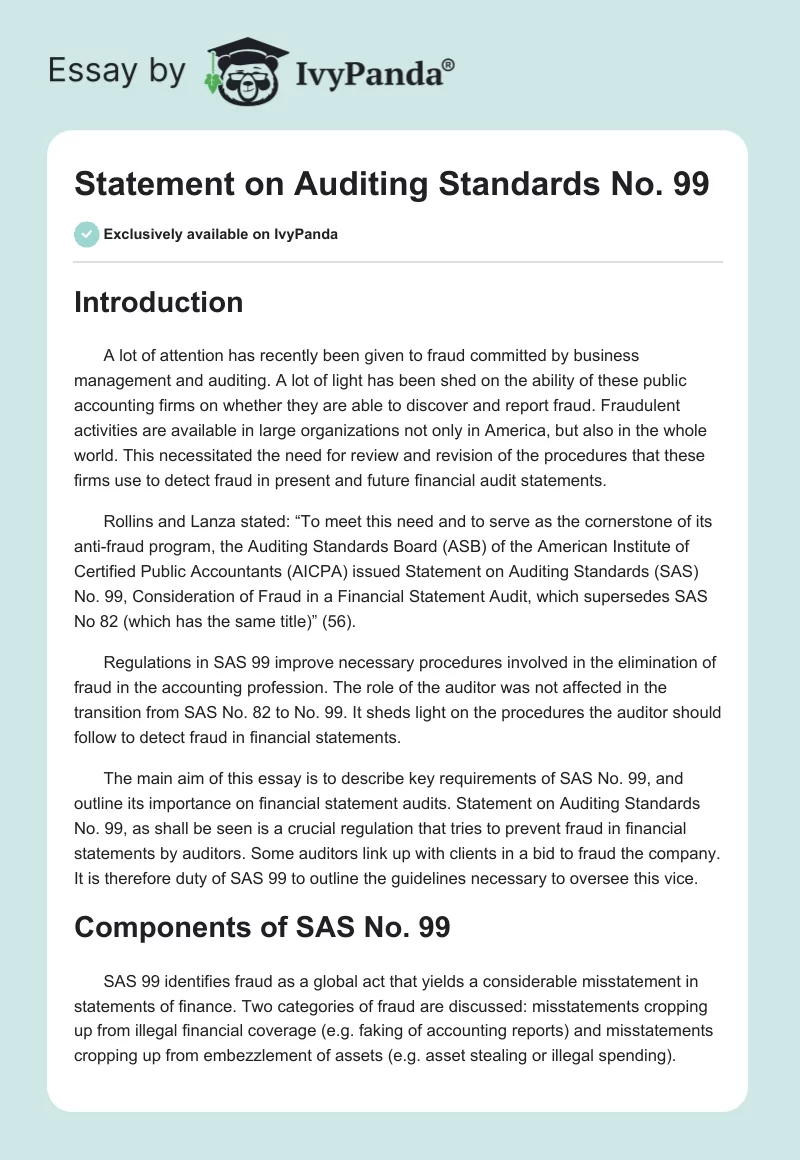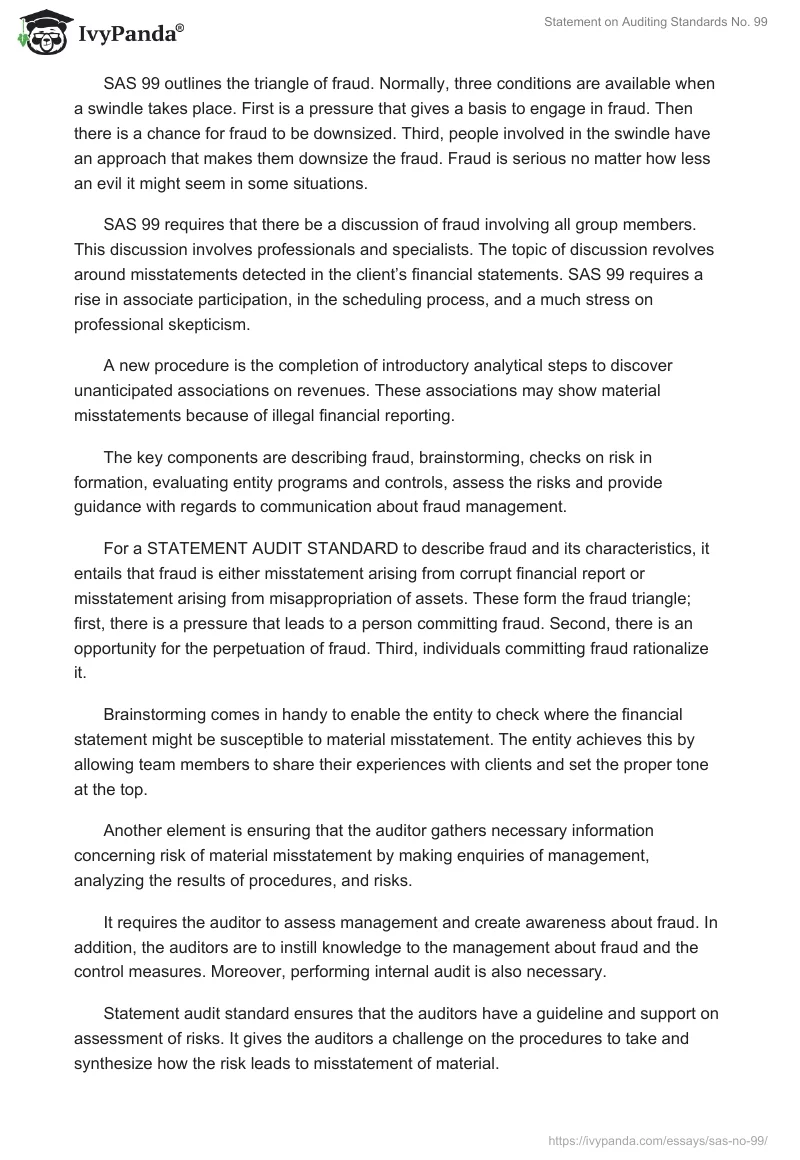Introduction
A lot of attention has recently been given to fraud committed by business management and auditing. A lot of light has been shed on the ability of these public accounting firms on whether they are able to discover and report fraud. Fraudulent activities are available in large organizations not only in America, but also in the whole world. This necessitated the need for review and revision of the procedures that these firms use to detect fraud in present and future financial audit statements.
Rollins and Lanza stated: “To meet this need and to serve as the cornerstone of its anti-fraud program, the Auditing Standards Board (ASB) of the American Institute of Certified Public Accountants (AICPA) issued Statement on Auditing Standards (SAS) No. 99, Consideration of Fraud in a Financial Statement Audit, which supersedes SAS No 82 (which has the same title)” (56).
Regulations in SAS 99 improve necessary procedures involved in the elimination of fraud in the accounting profession. The role of the auditor was not affected in the transition from SAS No. 82 to No. 99. It sheds light on the procedures the auditor should follow to detect fraud in financial statements.
The main aim of this essay is to describe key requirements of SAS No. 99, and outline its importance on financial statement audits. Statement on Auditing Standards No. 99, as shall be seen is a crucial regulation that tries to prevent fraud in financial statements by auditors. Some auditors link up with clients in a bid to fraud the company. It is therefore duty of SAS 99 to outline the guidelines necessary to oversee this vice.
Components of SAS No. 99
SAS 99 identifies fraud as a global act that yields a considerable misstatement in statements of finance. Two categories of fraud are discussed: misstatements cropping up from illegal financial coverage (e.g. faking of accounting reports) and misstatements cropping up from embezzlement of assets (e.g. asset stealing or illegal spending).
SAS 99 outlines the triangle of fraud. Normally, three conditions are available when a swindle takes place. First is a pressure that gives a basis to engage in fraud. Then there is a chance for fraud to be downsized. Third, people involved in the swindle have an approach that makes them downsize the fraud. Fraud is serious no matter how less an evil it might seem in some situations.
SAS 99 requires that there be a discussion of fraud involving all group members. This discussion involves professionals and specialists. The topic of discussion revolves around misstatements detected in the client’s financial statements. SAS 99 requires a rise in associate participation, in the scheduling process, and a much stress on professional skepticism.
A new procedure is the completion of introductory analytical steps to discover unanticipated associations on revenues. These associations may show material misstatements because of illegal financial reporting.
The key components are describing fraud, brainstorming, checks on risk in formation, evaluating entity programs and controls, assess the risks and provide guidance with regards to communication about fraud management.
For a STATEMENT AUDIT STANDARD to describe fraud and its characteristics, it entails that fraud is either misstatement arising from corrupt financial report or misstatement arising from misappropriation of assets. These form the fraud triangle; first, there is a pressure that leads to a person committing fraud. Second, there is an opportunity for the perpetuation of fraud. Third, individuals committing fraud rationalize it.
Brainstorming comes in handy to enable the entity to check where the financial statement might be susceptible to material misstatement. The entity achieves this by allowing team members to share their experiences with clients and set the proper tone at the top.
Another element is ensuring that the auditor gathers necessary information concerning risk of material misstatement by making enquiries of management, analyzing the results of procedures, and risks.
It requires the auditor to assess management and create awareness about fraud. In addition, the auditors are to instill knowledge to the management about fraud and the control measures. Moreover, performing internal audit is also necessary.
Statement audit standard ensures that the auditors have a guideline and support on assessment of risks. It gives the auditors a challenge on the procedures to take and synthesize how the risk leads to misstatement of material.
Statement audit standard also provides measures that explain the identified risks of material misstatement. Moreover, it evaluates the outcome of the audit procedures and other observation that affects the assessment. It ensures clear guidance on fraud management and how auditors communicate this vital information.
When documenting this important document the auditor should; give details on brainstorming session, procedures performed in assessment of risk and its results, give the efficiency of the management of the entity. This most of the time leads to unannounced visits by the audits to the entities.
Criticism of SAS 99
More than half of the procedures are recommended rather than necessary. An outstanding example is; it suggests that auditors appear at the client’s end during inventory audit without notifying the client. Practically, auditors inform clients in advance on the location that the audit would be implemented.
This easily provides an opportunity for fraud by the client. Auditors informing a client the location of the audit beforehand are only giving an alert that there would be an audit. It thus makes it easy for clients to cover their tracks where there was fraud. If a client knows that the audit results would reveal discrepancies in the statements of accounts, and then they would do all they can to make the records straight.
SAS 99 has also been criticized for not sealing gaps of expectations. The strategy suggested in the standard enhances expectation on the auditing career. Because of this, auditors have to consider the expectations of SAS 99 as the lowest work level needed to identify fraud. They must be able to protect any choice that does not follow any of the suggested procedures in SAS 99. It is their responsibility to ensure that all procedures are followed in detecting and handling fraud.
Conclusion
Public auditors should follow SAS 99 standards accordingly. This will help in the elimination of fraud, in financial statements. Procedures laid out in SAS No. 99 are crucial for auditors. Auditors use this standard to know the necessary steps they need to take in order to identify fraud in financial statements.
SAS 99 was created to give guidelines. It provides the foundation for malpractice assertions in accounting. They act as a guideline that defines the manner in which they should carry out the auditing process. SAS 99 inflict massive documentation obligations on the auditors than is necessary in SAS 82.
Works Cited
Rollins, Steven and Lanza, Richard. Essential Project Investment Governance and Reporting : Preventing Project Fraud and Ensuring Sarbanes-Oxley Compliance. New York: J. Ross Publishing, 2004. Print.


